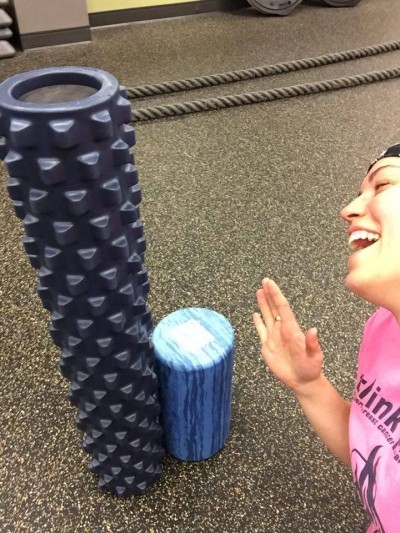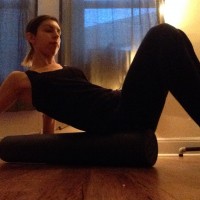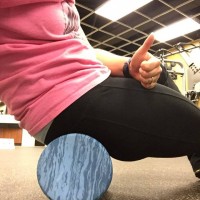Stretching is an important ritual for many dancers before and after class, and the effectiveness of pre-class stretching has been previously discussed here.

Since writing that article, a number of new warm-up and stretching techniques have risen in popularity, particularly the use of foam rollers to get your morning “crunchies” out. In fact it’s hard to find a dancer these days who’s not toting a foam roller under her arm.
Foam rollers are not the only way to get your roll on. Foam rolling is part of a bigger category known as Self-Myofascial Release (SMR), or self-massage. So, whether you use a foam roller or a roller that looks like a tire, or if you roll around on a softball, or use a foot massager, or stick those squishy spiked Franklin balls under your heels… it’s all the same principle, sharing the same philiosophy as massage therapy and other manual techniques used for many, many years.
Fascia 411
To better understand self-myofascial release, it’s helpful to understand a little bit about fascia:
Fascia is a web of tissue connecting the body’s compartments. Fascia’s job is to provide stability and directional pull for the muscles to best accomplish their jobs. Injury and repetitive use can contribute to fascia becoming less pliable, essentially building scar tissue and resulting in reduced range of motion, pain, and shortening of the surrounding muscles.
Myofascial release is designed to massage the damaged fascia and restore its natural pliability, while suppressing receptors that are stimulating the associated muscle tightness. Self-myofascial release allows the individual to monitor pain by conducting this process herself.
SMR brings additional blood flow to the area you are rolling, and perhaps for this reason has been integrated into many athletes’ warm-up routines. While this may prime the body for movement and sometimes feels good (other times it feels like a million needles poking into your thigh), the body responds in much the same way it responds to static stretching before activity.
So, why do people foam roll?
Is it just hype, or is there value in foam rolling?
Some clinicians feel that SMR manages the neuromuscular connections between muscles, creating a potential for improved movement patterns. The link between this idea and athletic performance isn’t too convincing at this point, but many athletes report better range of motion from foam rolling, and muscles tend to perform better when they can achieve full range of motion.
The simplest answer to the question, “to roll, or not to roll” is probably:
“Who knows?!?”
The jury is still out on whether foam rolling is bad, or good, or neither. At the time of this writing, it’s an emerging area of research and the argument in favor of foam rolling is largely justified by a whole lot of anecdotes.
Many athletes and coaches swear by their SMR routines, and most will likely tell you, “I don’t know how it works, but it works.” This seems to be the general consensus among researchers too, and until we have more concrete answers, it is unwise to make broad statements about foam rolling preventing injury or improving performance in any athlete.
Another possible answer to the SMR question is: “It depends.”
As dancers, we are obsessed with mobility. Any crunchy or tight area is perceived as a detriment. While foam rolling is thought by some to address areas of tightness and maladaptive movement patterns, we must also recognize the importance of balancing mobility with stability.
Our bodies’ joints form a kinetic chain in which alternating joints are ideal for providing stability (as in the knee and lower back), or mobility (ankle, hip, and thoracic/middle back areas). When in balance, our bodies move with ease and efficiency. However, through repetitive use or faulty movement patterns, we can change this balance and run the risk of getting injured. Dancers’ extreme hypermobility leaves us susceptible to injury, and so an intervention aimed at exacerbating mobility – which you already have a lot of – should be approached with caution.
Knowing where to roll isn’t as simple as it seems.

Muscle pain can result naturally as a part of the training process, or may be the result of overuse or faulty movement patterns. In using a foam roller, it’s tempting to simply attack the muscle that hurts, but the answer might not be so simple.
Understanding how the body compensates for a lack of muscular efficiency and knowing how to correct faulty movement patterns will help make the most of your time on the roller. For example, hip and knee pain is often attributed to the iliotibial band pulling at the side of the knee.

A common misconception is that tight IT bands are the culprit, when in fact poor or faulty musculature of the hip is often to blame. Plus, the IT band cannot simply be stretched out by foam rolling – it’s an incredibly tough, tight structure whose job is to stabilize the knee. In other words, even if you could roll out your IT band, you want it to be tight. A better approach is to combine SMR of the hip, glutes, and quads with some hip strengthening in extension and the lateral plane.
The article below from “hello healthy” gives additional insight on how to get the most out of foam rolling:
https://blog.myfitnesspal.com/are-you-foam-rolling-all-wrong/
The long and the short of foam rolling:
Will foam rolling make you less sore? Maybe.
Less tight? Probably.
But remember that soreness and tightness in small doses are a healthy part of the training process, and a signal to perhaps slow down a little bit instead of willing our bodies into submission with a softball.
There is a lack of convincing evidence to support long-lasting changes in muscle length by using SMR techniques on their own. In other words, SMR may not cause increased flexibility, per se, but can make traditional strength and flexibility training more effective by altering how the brain communicates with muscles to produce effective movement patterns.
There’s not enough research out there to definitively say whether or not foam rolling is “good” or “bad.” It just is. If it feels good (“good” being a relative term), do it, but understand that certain areas of your body are supposed to be tight. So go for it on your hips, butt, calves, thighs, and upper/middle back, and avoid the joints that are designed for stability: your knees, lower back, and neck. If you’re feeling pain in those places, spend time and energy seeing a doctor or physical therapist instead.
Additional reading:
National Academy of Sports Medicine: Why Should Foam Rolling Be Used in Group Training (Kyle Stull)
Lauren Warnecke is a freelance writer and editor, focused on dance and cultural criticism in Chicago and across the Midwest. Lauren is the dance critic for the Chicago Tribune, editor of See Chicago Dance, and founder/editor of Art Intercepts, with bylines in Chicago Magazine, Milwaukee Magazine, St. Louis Magazine and Dance Media publications, among others. Holding degrees in dance and kinesiology, Lauren is an instructor of dance and exercise science at Loyola University Chicago. Read Lauren’s posts.

